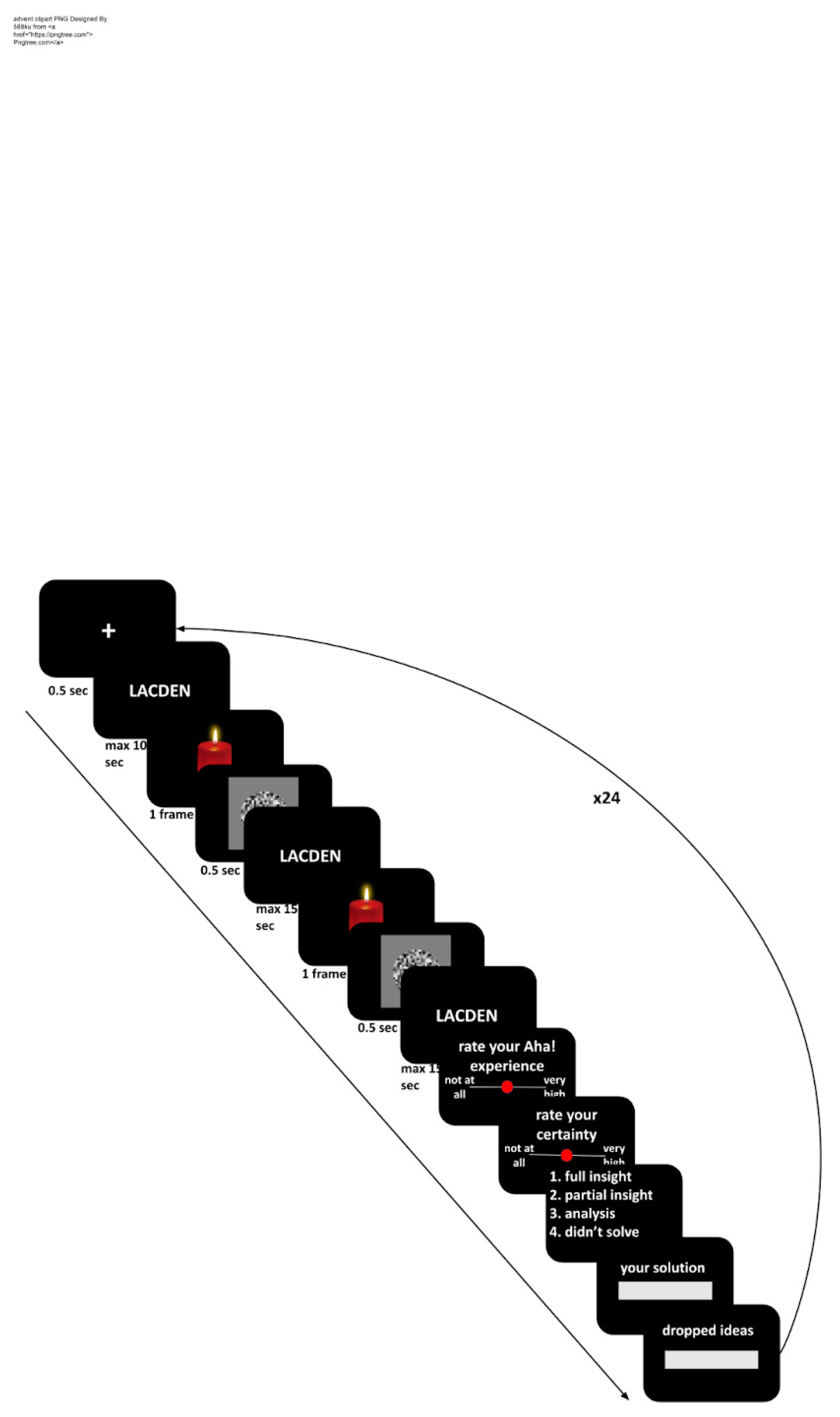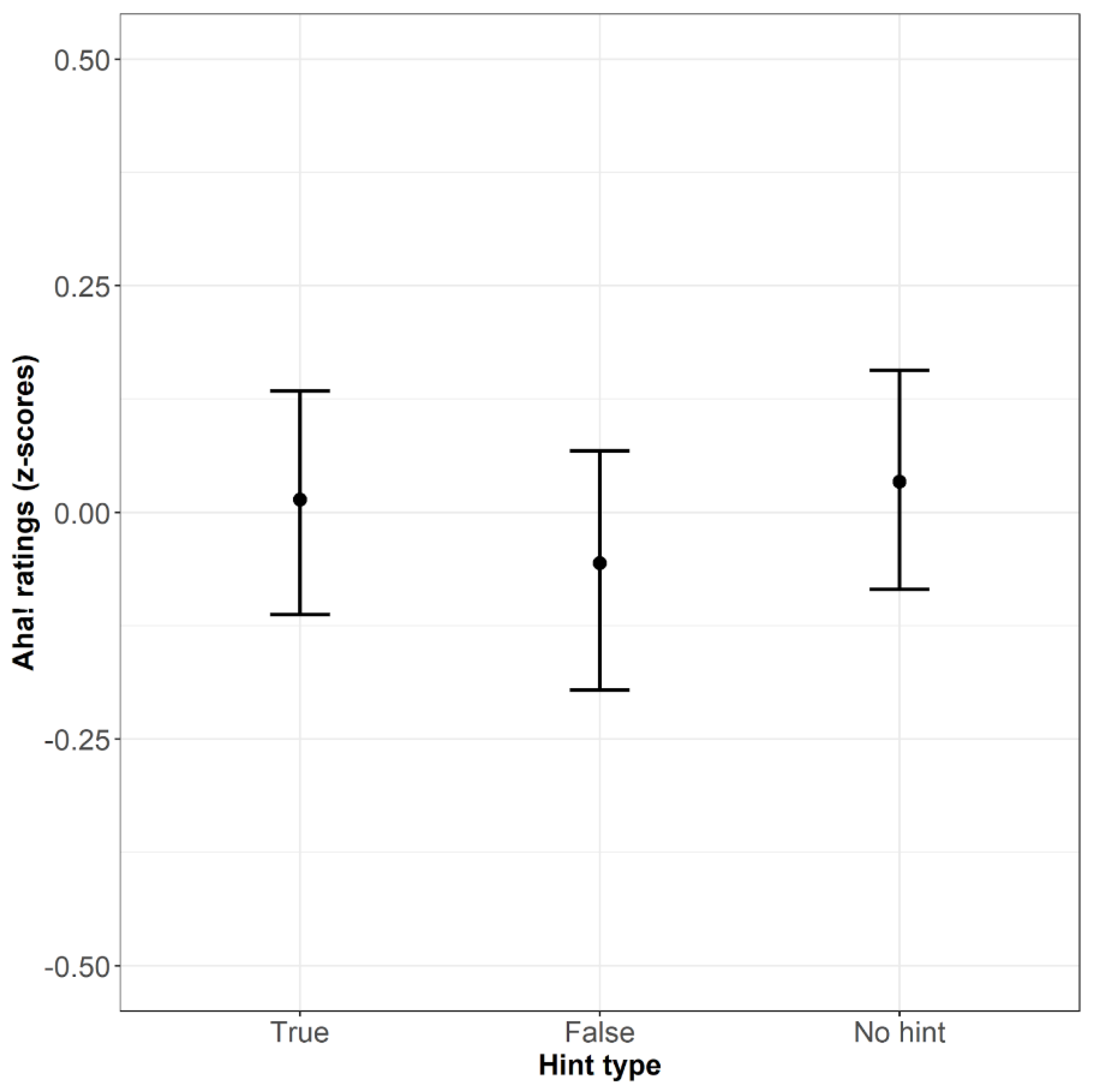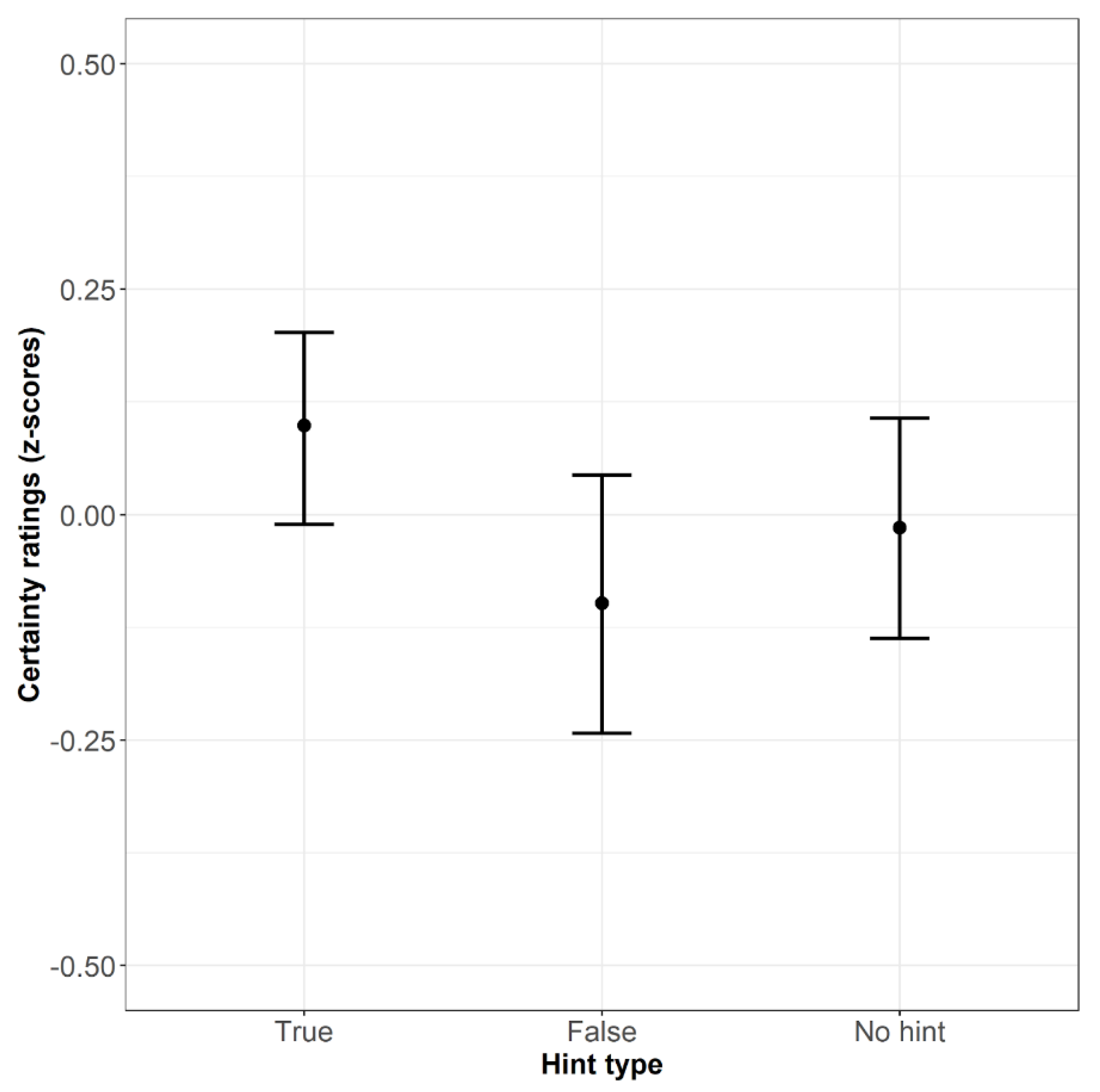Where Does Eureka Come From? The Effect of Unreportable Hints on the Phenomenology of Insight
Abstract
1. Introduction
1.1. The Effect of Hints on Insight Problem Solving
1.2. The Effect of the Hints on Cognitive Aspects of Insight Problem Solving
1.3. The Effect of Hints on the Phenomenology of Insight
1.4. Why Are the Effects of Hints on Cognitive and Affective Components of Insight Inconsistent?
1.5. This Study
2. Materials and Methods
2.1. Participants
2.2. Materials
2.3. Design and Procedure
Left arrow key: “The solution came to mind suddenly, seemingly out of nowhere. I have no awareness of having done anything to try to get the answer”(full insight)
Right arrow key: “I tried various letter arrangements to solve the anagram, but none of them seemed to work. Then, the solution came to mind suddenly”(partial insight)
Up arrow key: “I tried various letter arrangements to solve the anagram. I was able to build on one of these arrangements to work out the solution step by step”(non-insight)
Down arrow key: “I did not solve the anagram”.
2.4. Data Analysis
3. Results
3.1. The Probability of Correct Solutions and Intrusion Errors
3.2. Response Times of the Correct Solutions
3.3. The Way the Solution Is Found
3.4. Aha!-Experience Ratings
3.5. Certainty Ratings
4. Discussion
5. Conclusions
Author Contributions
Funding
Institutional Review Board Statement
Informed Consent Statement
Data Availability Statement
Conflicts of Interest
References
- Ammalainen, Artur, and Nadezhda Moroshkina. 2021. The effect of true and false unreportable hints on anagram problem solving, restructuring, and the Aha!-experience. Journal of Cognitive Psychology 33: 644–58. [Google Scholar] [CrossRef]
- Ash, Ivan, Patrick Cushen, and Jennifer Wiley. 2009. Obstacles in investigating the role of restructuring in insightful problem solving. Journal of Problem Solving 2: 3. [Google Scholar] [CrossRef]
- Bates, Douglas, Martin Mächler, Ben Bolker, and Steve Walker. 2015. Fitting Linear Mixed-Effects Models Usinglme4. Journal of Statistical Software 67: 1. [Google Scholar] [CrossRef]
- Becker, Maxi, Gregor Wiedemann, and Simone Kühn. 2020. Quantifying insightful problem solving: A modified compound remote associates paradigm using lexical priming to parametrically modulate different sources of task difficulty. Psychological Research 84: 528–45. [Google Scholar] [CrossRef] [PubMed]
- Bilalić, Merim, Mario Graf, Nemanja Vaci, and Amory Danek. 2019. When the Solution Is on the Doorstep: Better Solving Performance, but Diminished Aha! Experience for Chess Experts on the Mutilated Checkerboard Problem. Cognitive Science 43: 8. [Google Scholar] [CrossRef] [PubMed]
- Bilalić, Merim, Mario Graf, Nemanja Vaci, and Amory Danek. 2021. The temporal dynamics of insight problem solving—Restructuring might not always be sudden. Thinking & Reasoning 27: 1–37. [Google Scholar] [CrossRef]
- Bowden, Edward. 1997. The effect of reportable and unreportable hints on anagram solution and the aha! experience. Consciousness and Cognition 6: 545–73. [Google Scholar] [CrossRef]
- Bowden, Edward, and Mark Jung-Beeman. 2003. Normative data for 144 compound remote associate problems. Behavior Research Methods, Instruments, & Computers 35: 634–39. [Google Scholar] [CrossRef]
- Bowden, Edward, Mark Jung-Beeman, Jessica Fleck, and John Kounios. 2005. New approaches to demystifying insight. Trends in Cognitive Sciences 9: 322–28. [Google Scholar] [CrossRef]
- Chronicle, Edward, Thomas Ormerod, and James MacGregor. 2001. When Insight Just Won’t Come: The Failure of Visual Cues in the Nine-Dot Problem. The Quarterly Journal of Experimental Psychology Section A 54: 903–19. [Google Scholar] [CrossRef] [PubMed]
- Cranford, Edward, and Jarrod Moss. 2012. Is Insight Always the Same? A Protocol Analysis of Insight in Compound Remote Associate Problems. The Journal of Problem Solving 4: 2. [Google Scholar] [CrossRef]
- Danek, Amory. 2018. Magic tricks, sudden restructuring and the Aha! experience: A new model of non-monotonic problem solving. In Insight: On the Origins of New Ideas. Edited by F. Vallee-Tourangeau. Milton Park: Routledge, pp. 51–78. [Google Scholar]
- Danek, Amory, and Jennifer Wiley. 2017. What about False Insights? Deconstructing the Aha! Experience along Its Multiple Dimensions for Correct and Incorrect Solutions Separately. Frontiers in Psychology 7: 2077. [Google Scholar] [CrossRef] [PubMed]
- Danek, Amory, and Jennifer Wiley. 2020. What causes the insight memory advantage? Cognition 205: 104411. [Google Scholar] [CrossRef]
- Danek, Amory, and Virginia Flanagin. 2019. Cognitive conflict and restructuring: The neural basis of two core components of insight. AIMS Neuroscience 6: 60–84. [Google Scholar] [CrossRef] [PubMed]
- Danek, Amory, Joshua Williams, and Jennifer Wiley. 2020. Closing the gap: Connecting sudden representational change to the subjective Aha! experience in insightful problem solving. Psychological Research 84: 111–19. [Google Scholar] [CrossRef] [PubMed]
- Danek, Amory, Thomas Fraps, Albrecht von Müller, Benedikt Grothe, and Michael ÖLlinger. 2014. It’s a kind of magic—What self-reports can reveal about the phenomenology of insight problem solving. Frontiers in Psychology 5: 1408. [Google Scholar] [CrossRef]
- Davidson, Janet. 1995. The suddenness of insight. In The Nature of Insight. Edited by Robert Sternberg and Janet Davidson. Cambridge: The MIT Press, pp. 125–55. [Google Scholar]
- Duncker, Karl. 1945. On problem-solving. Psychological Monographs 58: 5. [Google Scholar] [CrossRef]
- Ellis, Jessica, and Eyal Reingold. 2014. The Einstellung effect in anagram problem solving: Evidence from eye movements. Frontiers in Psychology 5: 679. [Google Scholar] [CrossRef]
- Fleck, Jessica, and Robert Weisberg. 2013. Insight versus analysis: Evidence for diverse methods in problem solving. Journal of Cognitive Psychology 25: 436–63. [Google Scholar] [CrossRef]
- Gable, Shelly, Elizabeth Hopper, and Jonathan Schooler. 2019. When the muses strike: Creative ideas of physicists and writers routinely occur during mind wandering. Psychological Science 30: 396–404. [Google Scholar] [CrossRef]
- Green, Peter, and Catriona MacLeod. 2016. SIMR: An R package for power analysis of generalised linear mixed models by simulation. Methods in Ecology and Evolution 7: 493–98. [Google Scholar] [CrossRef]
- Grimmer, Hilary, Ruben Laukkonen, Jason Tangen, and William von Hippel. 2022. Eliciting false insights with semantic priming. Psychonomic Bulletin & Review 29: 954–70. [Google Scholar] [CrossRef]
- Hattori, Masasi, Steven Sloman, and Ryo Orita. 2013. Effects of subliminal hints on insight problem solving. Psychonomic Bulletin & Review 20: 790–97. [Google Scholar] [CrossRef][Green Version]
- Jacoby, Larry, and Kevin Whitehouse. 1989. An illusion of memory: False recognition influenced by unconscious perception. Journal of Experimental Psychology: General 118: 126–35. [Google Scholar] [CrossRef]
- Jung-Beeman, Mark, Edward Bowden, Jason Haberman, Jennifer Frymiare, Stella Arambel-Liu, Richard Greenblatt, Paul Reber, and John Kounios. 2004. Neural Activity When People Solve Verbal Problems with Insight. PLoS Biology 2: e97. [Google Scholar] [CrossRef]
- Kershaw, Trina, and Stellan Ohlsson. 2004. Multiple Causes of Difficulty in Insight: The Case of the Nine-Dot Problem. Journal of Experimental Psychology: Learning, Memory, and Cognition 30: 3–13. [Google Scholar] [CrossRef]
- Klein, Gary, and Andrea Jarosz. 2011. A Naturalistic Study of Insight. Journal of Cognitive Engineering and Decision Making 5: 335–51. [Google Scholar] [CrossRef]
- Kounios, John, and Mark Beeman. 2014. The Cognitive Neuroscience of Insight. Annual Review of Psychology 65: 71–93. [Google Scholar] [CrossRef]
- Laukkonen, Ruben, and Jason Tangen. 2018. How to detect insight moments in problem solving experiments. Frontiers in Psychology 9: 282. [Google Scholar] [CrossRef]
- Lüdecke, Daniel. 2021. Sjstats: Statistical Functions for Regression Models (Version 0.18.1). Available online: https://CRAN.R-project.org/package=sjstats (accessed on 30 July 2022).
- Maier, Norman. 1931. Reasoning in humans. II. The solution of a problem and its appearance in consciousness. Journal of Comparative Psychology 12: 181–94. [Google Scholar] [CrossRef]
- Moroshkina, Nadezhda, Alina Savina, Artur Ammalainen, Valeria Gershkovich, Ilija Zverev, and Olga Lvova. 2022. How Difficult Was It? Metacognitive Judgments About Problems and Their Solutions After the Aha Moment. Frontiers in Psychology 13: 911904. [Google Scholar] [CrossRef]
- Ohlsson, Stellan. 1992. Information-processing explanations of insight and related phenomena. Advances in the Psychology of Thinking 1: 1–44. [Google Scholar]
- Ohlsson, Stellan. 2011. Deep Learning: How the Mind Overrides Experience. Cambridge: Cambridge University Press. [Google Scholar]
- Overgaard, Morten, and Kristian Sandberg. 2021. The Perceptual Awareness Scale—Recent controversies and debates. Neuroscience of Consciousness 7: 1–8. [Google Scholar] [CrossRef] [PubMed]
- Peirce, Jonathan, and Michael MacAskill. 2018. Building Experiments in PsychoPy. Newcastle upon Tyne: Sage. [Google Scholar]
- Pétervári, Judit, and Amory Danek. 2019. Problem solving of magic tricks: Guiding to and through an impasse with solution cues. Thinking & Reasoning 26: 502–33. [Google Scholar] [CrossRef]
- R Core Team. 2017. R: A Language and Environment for Statistical Computing. Vienna: R Foundation for Statistical Computing. Available online: https://www.R-project.org/ (accessed on 30 July 2022).
- Reber, Rolf, Norbert Schwarz, and Piotr Winkielman. 2004. Processing Fluency and Aesthetic Pleasure: Is Beauty in the Perceiver’s Processing Experience? Personality and Social Psychology Review 8: 364–82. [Google Scholar] [CrossRef] [PubMed]
- Sadler-Smith, Eugene. 2015. Wallas’ four-stage model of the creative process: More than meets the eye? Creativity Research Journal 27: 342–52. [Google Scholar] [CrossRef]
- Seifert, Colleen, David Meyer, Natalie Davidson, Andrea Patalano, and Ilan Yaniv. 1995. Demystification of cognitive insight: Opportunistic assimilation and the prepared-mind perspective. In The Nature of Insight. Edited by Robert Sternberg and Janet Davidson. Cambridge: The MIT Press, pp. 65–124. [Google Scholar]
- Shen, Wangbing, Yuan Yuan, Chang Liu, and Jing Luo. 2016. In search of the ‘Aha!’ experience: Elucidating the emotionality of insight problem-solving. British Journal of Psychology 107: 281–98. [Google Scholar] [CrossRef]
- Source. 2022. Available online: https://pngtree.com/freepng/red-3d-candle-png_4579591.html (accessed on 19 February 2022).
- Spiridonov, Vladimir, Nikita Loginov, and Vladlen Ardislamov. 2021. Dissociation between the subjective experience of insight and performance in the CRA paradigm. Journal of Cognitive Psychology 33: 685–99. [Google Scholar] [CrossRef]
- Sternberg, Robert, and Janet Davidson. 1995. The Nature of Insight. Cambridge: The MIT Press. [Google Scholar]
- Stuyck, Hans, Bart Aben, Axel Cleeremans, and Evan Van den Bussche. 2021. The Aha! Moment: Is insight a different form of problem solving? Consciousness and Cognition 90: 103055. [Google Scholar] [CrossRef]
- Thomas, Laura, and Alejandro Lleras. 2009. Swinging into thought: Directed movement guides insight in problem solving. Psychonomic Bulletin & Review 16: 719–23. [Google Scholar] [CrossRef]
- Topolinski, Sascha, and Rolf Reber. 2010. Gaining Insight Into the “Aha” Experience. Current Directions in Psychological Science 19: 402–5. [Google Scholar] [CrossRef]
- Wallas, Graham. 1926. The Art of Thought. San Diego: Harcourt, Brace, vol. 10. [Google Scholar]
- Weisberg, Robert. 2015. Toward an integrated theory of insight in problem solving. Thinking & Reasoning 21: 5–39. [Google Scholar] [CrossRef]
- Weisberg, Robert, and Joseph Alba. 1981. An examination of the alleged role of “fixation” in the solution of several “insight” problems. Journal of Experimental Psychology: General 110: 169–92. [Google Scholar] [CrossRef]
- Whittlesea, Bruce, and Lisa Williams. 2001. The discrepancy-attribution hypothesis: II. Expectation, uncertainty, surprise, and feelings of familiarity. Journal of Experimental Psychology: Learning, Memory, and Cognition 27: 14–33. [Google Scholar] [CrossRef] [PubMed]





| Including Trials with Seen Hints | Excluding Trials with Seen Hints | |||
|---|---|---|---|---|
| Hint type | Correctly solved | Not solved (omissions and intrusions) | Correctly solved | Not solved (omissions and intrusions) 1 |
| True | .45 | .55 | .42 | .58 |
| False | .37 | .63 | .37 | .63 |
| No hint | .43 | .57 | .43 | .57 |
| Hint Type | Intrusion | No Intrusion |
|---|---|---|
| True | .13 | .87 |
| False | .21 | .79 |
| No hint | .15 | .85 |
Publisher’s Note: MDPI stays neutral with regard to jurisdictional claims in published maps and institutional affiliations. |
© 2022 by the authors. Licensee MDPI, Basel, Switzerland. This article is an open access article distributed under the terms and conditions of the Creative Commons Attribution (CC BY) license (https://creativecommons.org/licenses/by/4.0/).
Share and Cite
Ammalainen, A.; Moroshkina, N. Where Does Eureka Come From? The Effect of Unreportable Hints on the Phenomenology of Insight. J. Intell. 2022, 10, 110. https://doi.org/10.3390/jintelligence10040110
Ammalainen A, Moroshkina N. Where Does Eureka Come From? The Effect of Unreportable Hints on the Phenomenology of Insight. Journal of Intelligence. 2022; 10(4):110. https://doi.org/10.3390/jintelligence10040110
Chicago/Turabian StyleAmmalainen, Artur, and Nadezhda Moroshkina. 2022. "Where Does Eureka Come From? The Effect of Unreportable Hints on the Phenomenology of Insight" Journal of Intelligence 10, no. 4: 110. https://doi.org/10.3390/jintelligence10040110
APA StyleAmmalainen, A., & Moroshkina, N. (2022). Where Does Eureka Come From? The Effect of Unreportable Hints on the Phenomenology of Insight. Journal of Intelligence, 10(4), 110. https://doi.org/10.3390/jintelligence10040110




